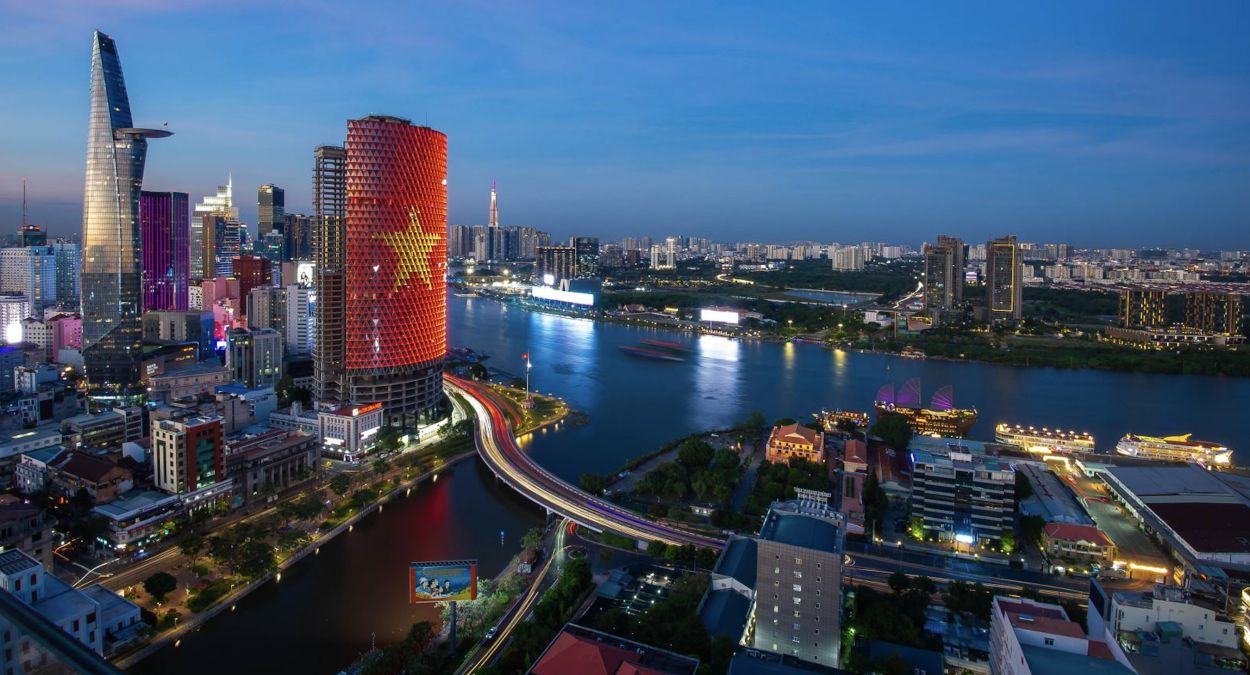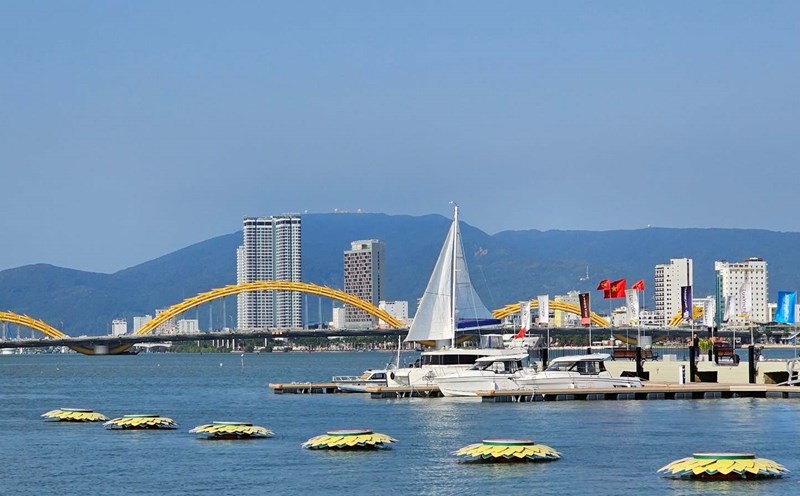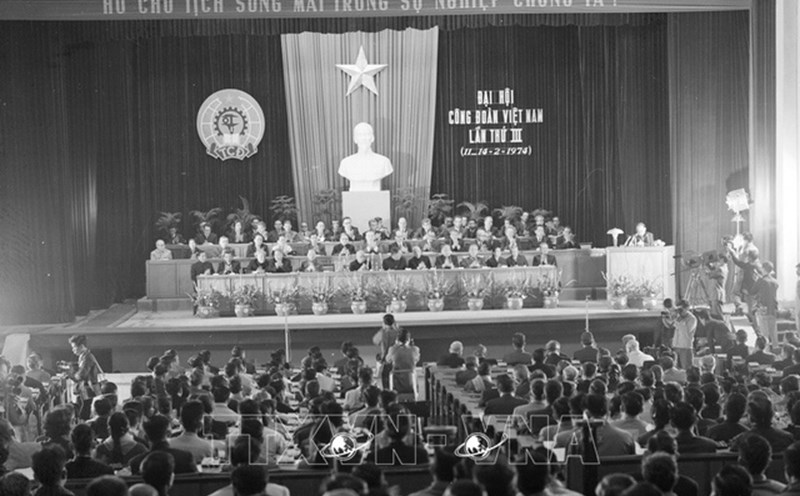All the rivers flow
On weekend evenings, a 2-storey cruise ship gently surfs the Han River, carrying more than 200 tourists in the sparkling lights of the Dragon Bridge. They not only experience waterway tourism but also have the opportunity to see the burning fireworks in the sky of the International Fireworks Competition that Da Nang has organized for many years.
On the boat, Mr. Pham Van Hoa (a tourist from Ho Chi Minh City) lifted a glass of wine, looked down at the sparkling water surface, and nodded: "I didn't expect Da Nang to have such beautiful waterway tourism. It is truly a city that is living with its river.
However, for Da Nang, waterway tourism is still not in line with the potential that needs to be exploited. The nearly VND10,000 billion project that Da Nang has just approved to implement is not simply an investment in tourism facilities. With the construction and renovation of 20 inland waterway wharves, combined with riverside parks, organizing clean fuel cruise tours, developing cultural and entertainment spaces on the banks of the Han River, Co Co, Vinh Dien..., Da Nang is reshaping the urban development approach towards "city by river".
The available advantage is the rich network of rivers, beautiful landscapes, poetic Han River and symbolic bridges. Lessons from Da Nang are a strategic vision: Not only focusing on exploiting tourism, but always integrating public transport, green space and community tourism into a synchronous and modern ecosystem.
If implemented on schedule, Da Nang can completely become a model of environmentally friendly river city, thereby leading to economic growth in tourism and improving the quality of urban life.
Mr. Nguyen Xuan Binh - former Deputy Director of the Department of Tourism, currently Director of the Department of Foreign Affairs of Da Nang - commented: "For a long time, Da Nang has developed coastal tourism very well, now it is time to return to the river. Waterway tourism is both green and experiential, very suitable for the new trend".
The story in Da Nang suggests a direction, a unique type of tourism product that has long been seemingly forgotten.
A typical example is Hanoi. The thousand-year-old capital possesses a tourism treasure but has not been properly awakened - the Red River. With a length of more than 160km flowing through Hanoi, on both banks are a system of pagodas and ancient craft villages such as Bat Trang, Duong Lam, Nhat Tan, and the Red River with the potential to become a "cultural tourism axis" if planned and invested appropriately.
In fact, the current Red River tours are very modest. The infrastructure of the wharf is lacking, licensing regulations are still overlapping, low-quality yachts, and products are not professional. Many investors "yachted into the Red River and pulled it back" because they could not survive the institutional barriers and weak infrastructure.
Tourism experts analyzed: "The Red River is a treasure, but no one dares to invest properly because of weak wharf infrastructure, overlapping licensing regulations, businesses pulling on cruise ships and having to withdraw".
A survey from the Asian Tourism Institute in 2024 shows that 70% of foreign tourists coming to Hanoi are willing to spend more to experience the river associated with craft village culture - if there are suitable products.
Sitting down to dinner at a food restaurant at Ngoc Lam food market on the other side of Long Bien bridge, seeing the Red River reflecting the sparkling light from the more than 100-year-old bridge on the water, Ms. Ngoc Hoa - a tourist in Hanoi said: "I have been to Bangkok, Thailand and experienced traveling on the Chao Phraya River and was really impressed with their way of doing waterway tourism. Thinking about Hanoi's Red River is so regrettable. What Hanoi needs is a serious Red River tourism plan, from Chuong Duong - Bat Trang - Son Tay, associated with festivals, experiences, and eco-resorts. We cannot just let the Red River " sleep and forget" like now.
Hanoi used to have an orientation to develop tourism on To Lich River and Nhue River, but it seems that until now it is still a "relic" story because to do tourism, the river water must first be clean. Until now, the Nhue River - one of the most polluted rivers in Hanoi - has only been built with embankments in some sections, while the To Lich River is still struggling to "change water".
In March 2025, the Office of the Hanoi People's Committee issued a notice on the conclusion of Vice Chairman of the City People's Committee - Duong Duc Tuan on the design plan to renovate the To Lich River. Accordingly, the city basically agrees with the research direction and proposal of Sun Group Joint Stock Company - Sun Group, the basic design plan meets the city's criteria and orientations and the programs and plans that have been and are being implemented, with the goal of turning To Lich River into a green space, a landscape and ecological highlight serving the community.

But when will it be? We have to wait.
Is Ho Chi Minh City better? Tran Song Hai - General Director of Greenlines DP Company Limited, a company providing waterway tourism services, especially tours to the Saigon River, said: "HCMC has great potential for waterway tourism but perhaps still needs more "push-ups".
5 years ago, Mr. Hai's Greenline DP Company opened the 78km long Ben Bach Dang - Cu Chi - Binh Duong waterway cruise route. This event marks a breakthrough not only for the tourism industry but also for waterway transportation activities when for the first time in more than 100 years, there is a seamless waterway along the Saigon River connecting the center of Ho Chi Minh City, Cu Chi and Binh Duong provinces.
As the urban area with the most dense river and canal system in the country, Ho Chi Minh City owns over 900km of inland waterways, connecting with the Southeast and Mekong Delta. From cruise tours on the Saigon River to the inter-provincial route to Can Gio, Cu Chi, Ben Tre..., the city has had significant launches.
However, the biggest obstacle is the lack of international standard wharves, especially in the central area. The licensing of the wharf is still delayed, the high cost of anchoring and the unsynchronized reception infrastructure system are reducing competitiveness. Meanwhile, the number of customers with high demand has increased rapidly, especially international customers and luxury tourists.
Ho Chi Minh City needs a big boost - such as building an "international tourist port center" at Bach Dang wharf, combining tourism, trade, and performing arts along the river, to turn the Saigon River into a modern tourism - cultural - economic axis like the Chao Phraya River of Bangkok (Thailand) or the River River River River River of Paris (France).
In contrast to the North, Hai Phong owns more than 50 large and small rivers, associated with historical achievements such as Bach Dang, Cam, Van Uc... with the position of seaport, Hai Phong has double advantages in developing waterway tourism: both having cultural and historical values and potential to connect international tourism logistics.
However, development here still mainly stops in Cat Ba. The rest are spontaneous, broken, lacking typical products. The city still does not have a cruise port that meets international standards, the riverbank landscape in many places is polluted, the route is unclear, and the products are poor.
To fully exploit the value of the river, Hai Phong needs to have a comprehensive plan for night tourism routes on the Cam River, pick-up and drop-off wharves combined with food areas, river art performances, and landscape lighting. Moreover, it is necessary to mobilize private investment and develop inter-provincial tours connecting Ha Long, Ninh Binh, and Hanoi.
Unflowing waterway tourism
With more than 2,360 large and small rivers, nearly 3,260km of coastline, and a diverse canals ecosystem across the country, Vietnam has all the conditions to develop waterway tourism - a type of ecology, identity and unique experience.
However, currently, waterway tourism still accounts for only a small proportion of the tourism industry structure. The products are still mainly spontaneous, short-range, lacking highlights, not creating regional chains, not attracting high-spending customers or international visitors.
According to Dr. Tran Huu Hiep - Vice President of the Mekong Delta Tourism Association: "Vietnam's waterway tourism is facing great opportunities but also facing a series of barriers: From lack of overall planning, weak infrastructure, poor products, to overlapping management institutions".
At the Waterway Tourism Development Workshop held in Hai Phong in April 2025, Director of the Vietnam National Administration of Tourism - Nguyen Trung Khanh said that it is necessary to build waterway tourism products, something that tourists expect to experience in their journey of discovery. Building rich, quality products that meet the diverse tastes of customers is an urgent requirement in the current context of fierce competition.
With the goal of becoming one of the attractive river tourism destinations in Southeast Asia, Vietnam needs to build a brand by building unique and outstanding river tourism products - Director Nguyen Trung Khanh commented.
As for Associate Professor, Dr. Bui Thanh Thuy - Head of the Department of Tourism, Hanoi University of Culture - emphasized: "There must be a systematic plan. Not every river section can be exploited for tourism. The planning needs to clearly divide: Tourist routes, stops, support service areas and environmental protection corridors".
From the business side, Ms. Lieu Thi My Hanh - Executive Director of Les Rives Company - proposed the solution of investing in building a system of cruise ships and tourist pick-up and drop-off ports that meet national and international standards. It is necessary to arrange land, give policy incentives and encourage businesses to socialize investment in wharves, especially in large cities such as Ho Chi Minh City, Hanoi, Hai Phong, Da Nang.
Currently, waterway tourism management is dominated by many sectors: Transportation, tourism, waterway police, environment... This causes difficulties in licensing, operation, and inspection. Dr. Vu Quoc Tri - General Secretary of the Vietnam Tourism Association - said: "It is necessary to build a separate legal framework for waterway tourism, transparency, simplicity and business support".
At the same time, encourage private investment, develop the PPP (public-private partnership) model in developing wharves, vehicles, and tourist fleets. The State plays a role in creating and supporting access to credit, land and appropriate tax policies.
Waterway tourism is not only the story of the tourism industry, but also a green development strategy, sustainable growth for urban areas, riverside areas and local communities. When knowing how to exploit it properly, waterway tourism not only opens up a new journey of discovery for tourists but also helps cities "relieve" traffic pressure, develop a green economy, and preserve indigenous cultural values.
Da Nang has gone ahead by action. Hanoi, Ho Chi Minh City and Hai Phong, along with localities with potential for inland waterway tourism, need to accelerate - not only to catch up, but also to open a new development corridor: Corridor of Vietnam's tourism rivers.











